Optimizing Banking Infrastructure for Scalability and Cost Efficiency in 2025
Table of content
Introduction
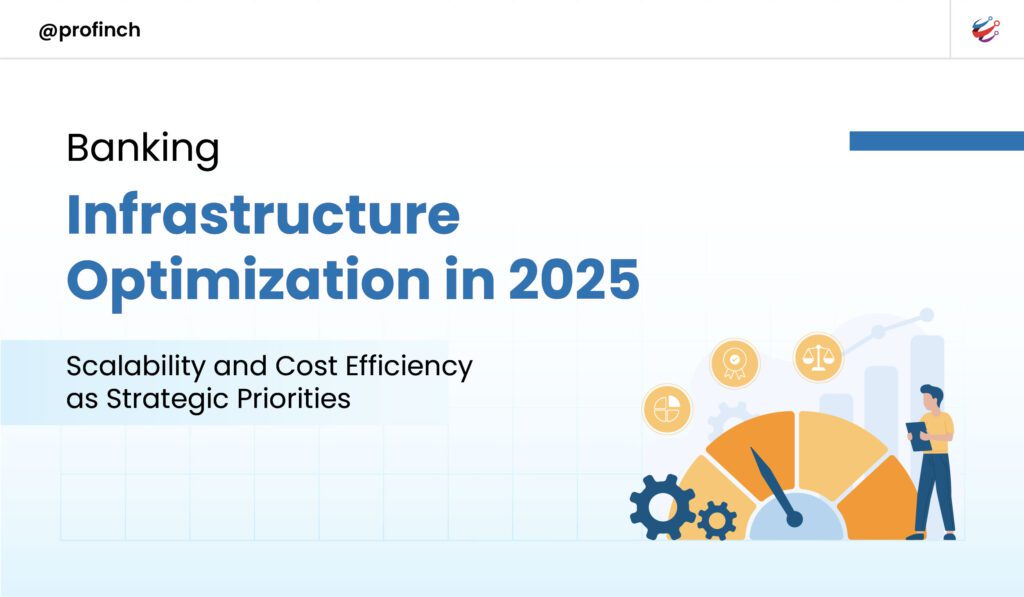
In the financial services sector, IT infrastructure serves as the backbone of operational efficiency, customer engagement, and regulatory compliance. With the rise of digital banking, escalating customer expectations, and increasing transaction volumes, banks must evolve their IT infrastructure to remain competitive, and it’s no more an option but is a strategic imperative.
Thus, a modern, scalable, and cost-efficient infrastructure is no longer a luxury but a necessity. However, achieving the right balance between scalability and cost efficiency presents challenges that require thoughtful planning, innovative technologies, and a strategic approach.
This whitepaper explores the need for optimized IT infrastructure in banking, challenges institutions face, strategies for success, and the technologies enabling the transformation.
The Need for IT Infrastructure Optimization
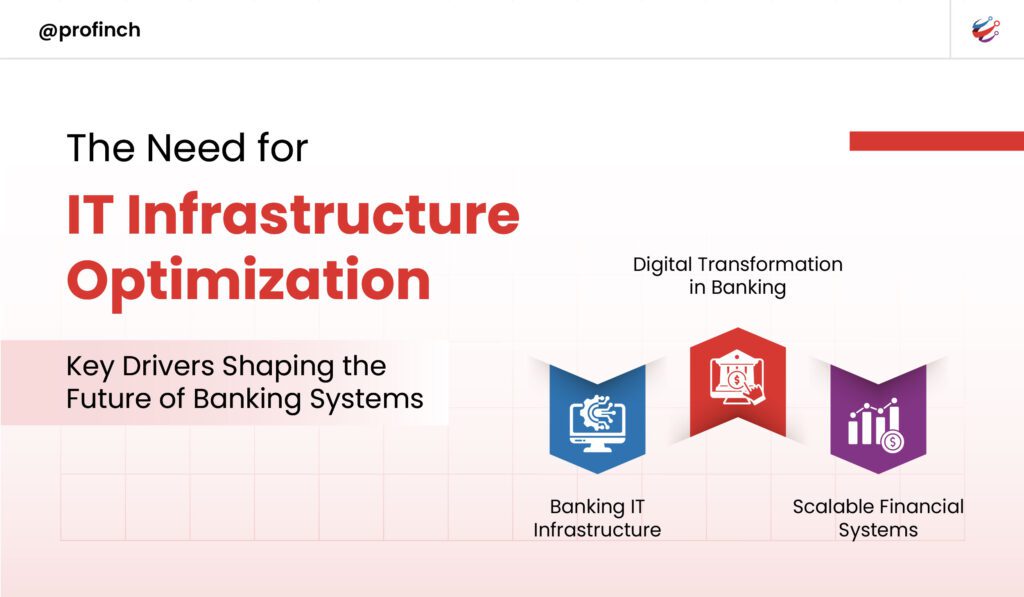
The banking industry is transforming rapidly, driven by the adoption of digital channels, customer-centric services, and the integration of emerging technologies like artificial intelligence (AI) and blockchain. Banks are now expected to process millions of transactions per second, ensure zero downtime, and deliver seamless, real-time customer experiences.
Key Drivers for Optimization
- Increased Digital Transactions
Handle high transaction volumes without performance bottlenecks. The shift from branch banking to digital channels has amplified transaction volumes, necessitating infrastructure that can handle surges during peak periods without degradation in performance. - Customer Expectations
Today’s customers demand faster transactions, personalized services, and 24/7 availability. To meet these expectations, banks need highly scalable and resilient systems. The ability to seamlessly integrate technologies such as cloud, artificial intelligence. - Regulatory Compliance
Rapidly adapt to regulatory changes and emerging market demands. Compliance with stringent regulations and data security mandates often requires regular upgrades and system overhauls, adding complexity to infrastructure management. - Cost Management
Traditional IT systems are resource-intensive, with high operating costs for maintenance, energy consumption, and hardware upgrades. Optimizing infrastructure is essential to reduce these costs while delivering better performance.
Challenges in Infrastructure Optimization
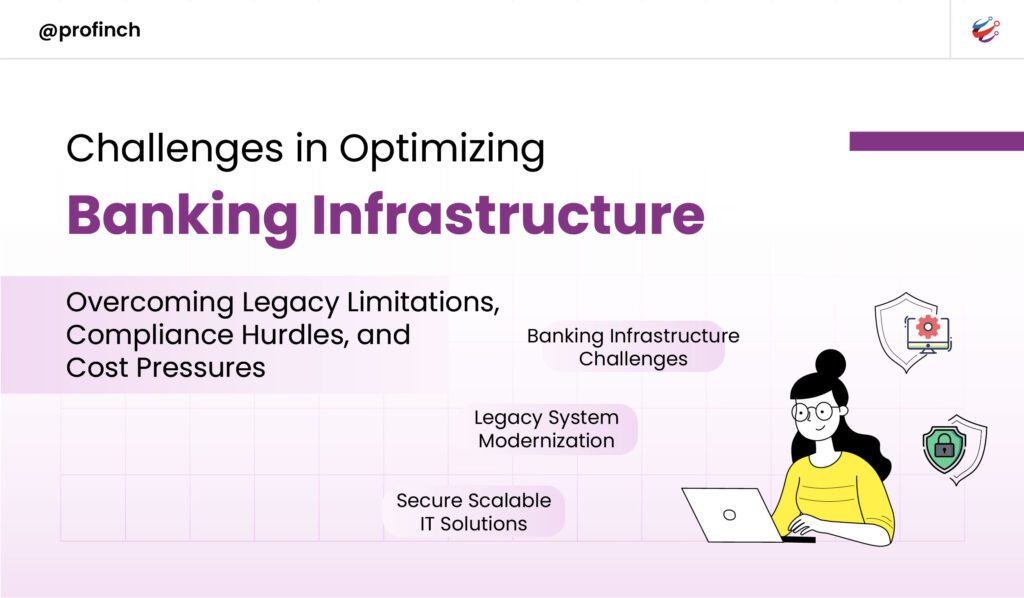
Modernizing IT infrastructure for scalability and cost efficiency is fraught with challenges, especially in a sector as complex as banking. Banks require infrastructure solutions that minimize upfront investments, optimize operational expenses, and deliver long-term value.
- Legacy Systems
Legacy systems often lack the flexibility to integrate with modern technologies. Migrating these systems to a modern, scalable infrastructure requires significant effort, time, and investment. - Balancing Scalability with Cost
Scaling infrastructure to handle higher transaction volumes often leads to increased costs, particularly in hardware acquisition and data centre expansions. Balancing scalability with cost efficiency requires innovative solutions such as cloud adoption and virtualization. - Data Security and Compliance
Banks must ensure that infrastructure optimization efforts align with strict regulatory requirements, such as GDPR or PCI DSS. Failure to do so can result in hefty penalties and reputational damage. - Operational Disruptions
Infrastructure upgrades or migrations often lead to temporary disruptions, impacting customer experience and business continuity. Mitigating these risks is critical during optimization efforts. - Dependency
Many cases, banks have to mostly rely on third-party vendors for changes and agile customisations even after go-live, which leads to challenges in long-term scalability.
Strategies for IT Infrastructure Optimization
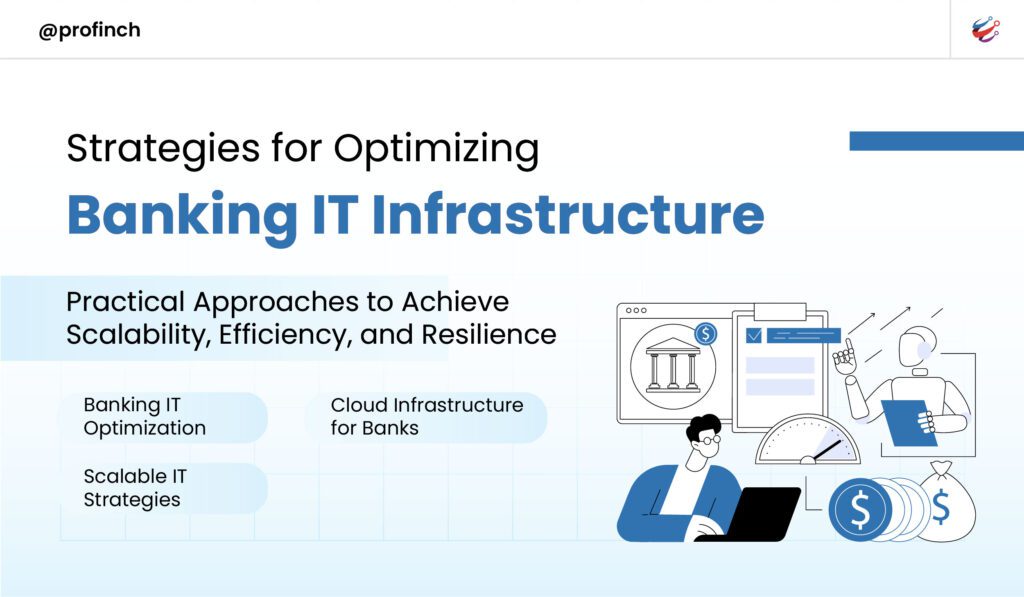
To overcome these challenges and achieve scalable, cost-efficient IT infrastructure, banks can adopt the following strategies:
- Partner with a Banking-Specific Infrastructure Solutions Provider
Choose a solutions partner that specializes exclusively in the banking sector and has a global track record of scaling infrastructure for banks. Such a partner brings domain expertise to design scalable, future-ready systems tailored to banking operations, and suggest a roadmap for seamless modernization.
They should also empower banks to achieve self-sufficiency by providing the tools, training, and frameworks necessary to introduce customizations, implement changes, or roll out new features internally, without relying on third-party vendors. This reduces long-term dependency, lowers costs, and ensures faster adaptability to evolving market needs. - Embrace Cloud Computing
Cloud technology offers unparalleled scalability and cost efficiency, allowing banks to scale up or down based on demand. By migrating to the cloud, banks can reduce hardware costs, improve disaster recovery capabilities, and ensure high availability.
Public Cloud: Ideal for non-sensitive workloads and customer-facing applications.
Private Cloud: Suitable for sensitive data and core banking operations.
Hybrid Cloud: Combines the best of both worlds, offering flexibility and cost optimization. - Adopt Modular Infrastructure
Modular infrastructure allows banks to scale specific components of their IT systems without overhauling the entire infrastructure. For example, a modular data center can be expanded as needed to accommodate growth in transaction volumes. - Implement Virtualization
Virtualization enables multiple applications to run on a single physical server, improving resource utilization and reducing hardware costs. This approach also enhances flexibility and simplifies disaster recovery. - Leverage Automation, Invest in Data Analytics
Automation tools can streamline routine IT tasks, such as system monitoring, patch management, and incident resolution. This not only reduces operational costs but also minimizes human errors, ensuring better system performance.
Advanced analytics can help optimize the IT infrastructure by predicting demand patterns, identifying inefficiencies, and automating resource allocation.
For example, data driven predictive maintenance can identify potential system failures before they occur, reducing downtime and repair costs. Check Atumverse for instance. - Focus on Energy Efficiency
Energy-efficient infrastructure not only reduces operational costs but also aligns with sustainability goals. Banks can invest in energy-efficient servers, cooling systems, and renewable energy sources to achieve this. - Strengthen Cybersecurity Measures
Optimizing IT infrastructure without robust security measures can expose banks to cyber threats. Implementing advanced security tools, such as intrusion detection systems and encryption, ensures data integrity and compliance with regulations.
Technologies Driving Infrastructure Optimization
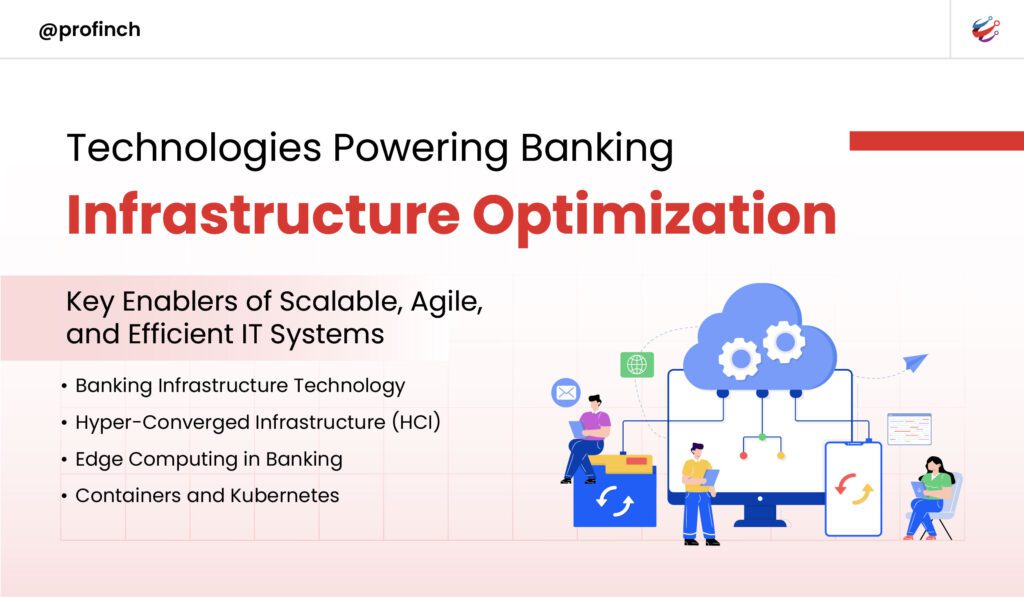
Several technologies play a pivotal role in enabling scalable and cost-efficient IT infrastructure in banking:
- Hyper-Converged Infrastructure (HCI)
HCI integrates compute, storage, and networking into a single system, simplifying management and improving scalability. It is particularly beneficial for banks looking to consolidate their infrastructure. - Edge Computing
Edge computing reduces latency by processing data closer to the source. This is especially useful for applications like mobile banking and real-time fraud detection, where speed is critical. - Software-Defined Networking (SDN)
SDN provides centralized control over network resources, enabling banks to optimize bandwidth allocation and improve network performance. - Containers and Kubernetes
Containers offer lightweight, portable environments for deploying applications, while Kubernetes automates the management of these containers. Together, they enable seamless scalability and resource optimization.
Best Practices for Successful Banking Infrastructure Optimization
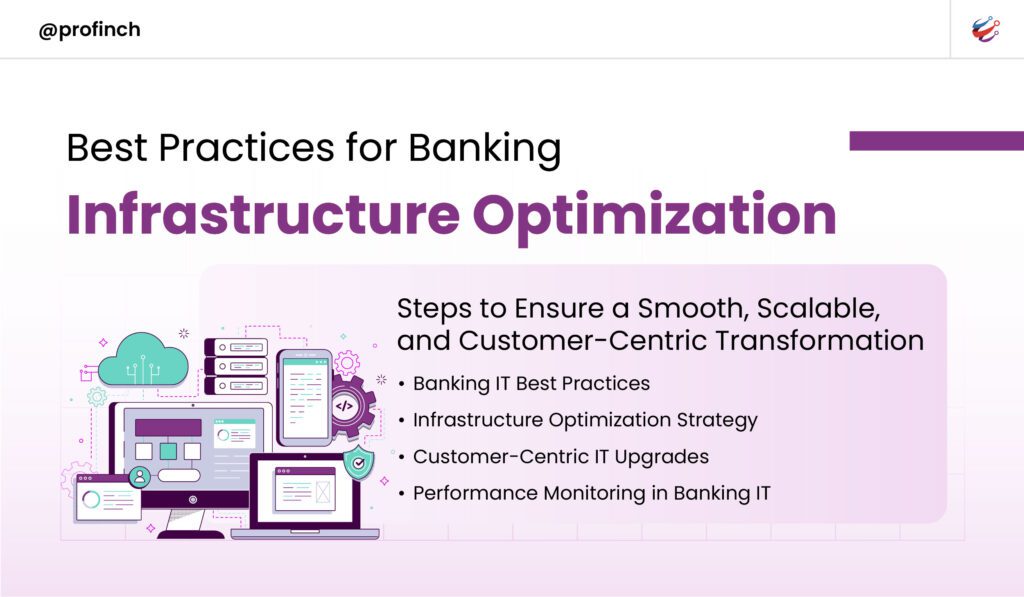
- A Comprehensive Assessment
First is, a thorough evaluation of existing infrastructure to identify pain points, inefficiencies, and opportunities for improvement. - A Clear Roadmap
Then emerges clear objectives, timelines, and milestones for the optimization process. A phased approach minimizes disruptions and ensures a smooth transition. - Engage Stakeholders
Collaboration between IT, operations, and business teams is crucial to align infrastructure optimization efforts with organizational goals. - Choose the Right Vendors
Partner with a specialised banking infrastructure solutions provider who understand the banking sector’s unique challenges and offer customized solutions. - Prioritize Customer Experience
Ensure that infrastructure upgrades do not disrupt customer interactions. Seamless service delivery should remain a top priority throughout the optimization process. - Measure and Monitor
Establish key performance indicators (KPIs) to measure the success of optimization efforts. Regular monitoring ensures that the infrastructure continues to deliver value over time.
Conclusion
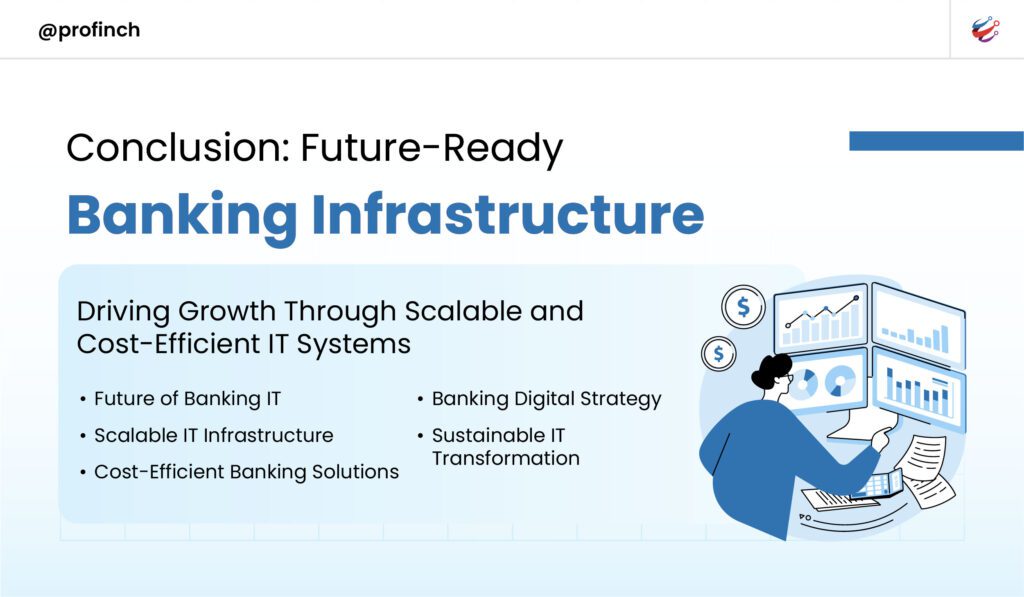
Optimizing IT infrastructure for scalability and cost efficiency is a critical step for banks aiming to thrive in the digital age. Modern infrastructure not only enhances operational efficiency but also enables banks to deliver superior customer experiences, comply with regulations, and adapt to evolving market demands.
By adopting innovative technologies, implementing best practices, and addressing key challenges, banks can build infrastructure that supports long-term growth and sustainability.
Scalability and cost efficiency are not mutually exclusive, when approached strategically, they can work hand in hand to drive the future of banking.
For tailored IT infrastructure solutions, reach out to us at Profinch, where innovation meets efficiency.
The Profinch Advantage
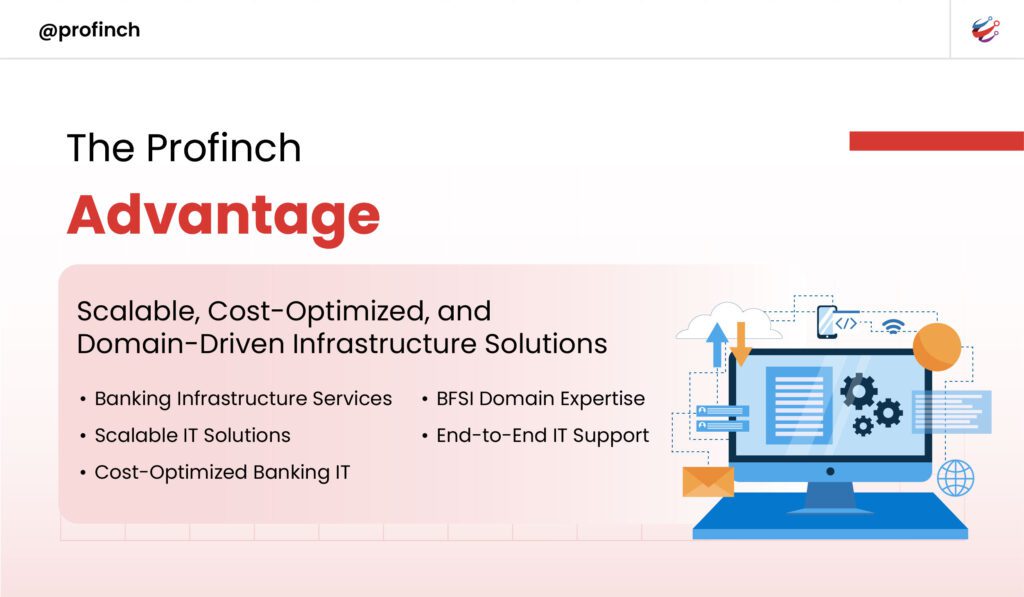
Profinch’s infrastructure services stand out in their ability to deliver customized solutions that balance scalability, performance, and cost efficiency. Key differentiators include:
- Domain Expertise in BFSI
Profinch’s team comprises Subject Matter Experts (SMEs) with hands-on experience in banking operations. This ensures that our solutions align with industry-specific requirements and compliance standards. - Cost-Optimized Solutions
We emphasize cost optimization by offering modular, cloud-ready infrastructure designs. Our approach minimizes total cost of ownership (TCO) while maximizing ROI for clients. - Seamless Scalability
Our solutions are built for growth, enabling banks to scale their infrastructure to accommodate increasing transaction volumes, new services, and multi-country operations without disruptions. - End-to-End Support
From assessment and design to implementation and maintenance, Profinch delivers comprehensive infrastructure solutions. Our proactive monitoring and support services ensure sustained performance and reduced downtime. - Always Available, Always Banking-Specific
Profinch is your partner in infrastructure modernization, whether you aim to scale operations, introduce digital capabilities, or secure your systems. With an exclusive focus on banking, we take care of it all, ensuring your infrastructure supports innovation, security, and long-term cost efficiency.
Profinch sets the global benchmark for infrastructure excellence, empowering banks to stay ahead in the ever-evolving financial landscape.
Speak to us to understand how our consulting solutions and products are shaping the future of BFSI.
Other Blogs
One of the major reasons for banks to adopt a digital platform is to increase operational efficiency and reduce client dependency on banks.
Customers frequently need an end-to-end picture of the status of their transactions. Payment and trade trackers are two examples of useful features that give users up-to-date information on the status of their transactions in real time. They are able to see, for example, whether the transaction is awaiting approval from a person in their organization, and how many more authorization levels are required before it reaches the bank’s processing queue, or whether the bank needs any further details, due to the additional due diligence required. The transaction can be returned for more documents/validation or data if the bank requests them, facilitating easy communication.
In the current climate, where multiple regions require heightened security and compliance inspections, this is especially crucial. In addition to reducing the need for manual intervention, having a robust two-way communication process gives the consumer a more efficient and fulfilling experience by giving them a sense of information and control throughout the process.
Users should be able to see the acknowledgment status of the networks as well as SWIFT communications related to their transactions. With the help of this feature, customers may keep an eye on whether their money has been handled properly by their bank and has reached the receiving bank, providing a clearer picture of the transaction’s path.
Users can feel more assured that their money has been transferred correctly and on schedule when they have access to this level of information. It contributes to a more seamless and informed banking experience, by reducing uncertainty, decreasing the need for updates from the bank, and increasing transparency. This functionality is critical for businesses managing large or international transactions, when confirming the recipient bank’s receipt of the funds.
Frequently Asked Questions (FAQs)
How to Optimize Banking Infrastructure?
Optimizing banking infrastructure begins with aligning technological investments with strategic goals. The process starts with an assessment of existing systems, identifying inefficiencies, and defining objectives such as scalability, cost savings, and improved performance. A phased approach is ideal to minimize disruptions, ensuring continuity in critical operations.
Banks should focus on adopting flexible solutions like hybrid cloud architectures, modular systems, and virtualization. Automation tools should be deployed to manage routine IT tasks, such as system monitoring and issue resolution, while reducing manual errors. Data analytics and AI can further enhance infrastructure efficiency by predicting system demand, streamlining resource allocation, and preventing failures before they occur. Integration of advanced security protocols is essential to ensure compliance and protect sensitive customer data.
How to Identify the Need for an Banking Infrastructure Upgrade?
Recognizing when your banking infrastructure requires an upgrade is crucial for staying competitive. Warning signs often manifest as operational inefficiencies, frequent system downtimes, slow transaction processing, and high maintenance costs. If systems struggle to handle increasing transaction volumes or fail to integrate with modern technologies, it may be time for a revamp.
Customer experience is another key marker. Delayed transactions, unresponsive mobile banking apps, and frequent service outages indicate infrastructure that cannot keep up with user expectations. Additionally, regulatory compliance pressures can highlight gaps in existing systems, especially if they lack the necessary tools for data security and reporting.
What are the Markers of Outdated Banking Infrastructure?
Outdated infrastructure often exhibits tell-tale markers that hinder scalability and performance. These include:
- High Operating Costs: Aging systems typically require costly maintenance and consume excessive power.
- Limited Scalability: Legacy systems often cannot scale to handle increased workloads, leading to bottlenecks during peak periods.
- Integration Challenges: Lack of interoperability with modern tools and platforms impedes digital transformation efforts.
- Frequent Downtime: Prolonged outages and system failures disrupt operations and damage customer trust.
- Inflexible Architecture: Rigid, non-modular designs make upgrades expensive and time-consuming.
Banks should regularly monitor these markers to determine the readiness for a technology overhaul.
How to Choose a Vendor for Banking Infrastructure Solutions?
Multiple choices without distinct differentiators often leads to paralysis by analysis or unsatisfactory outcome, wastage of resources, and most importantly, time.
Look for vendors with proven experience, specifically in the banking and financial services industry (BFSI), as they understand the unique challenges of the sector. Evaluate their track record in delivering scalable, secure, and cost-efficient solutions tailored to regulatory requirements.
Key criteria include:
- Customization Capabilities: The ability to design solutions that align with your bank’s specific goals.
- Scalability: Ensure the vendor’s solutions can grow with your business needs.
- Proactive Support: Vendors offering 24/7 monitoring and quick resolution services minimize downtime risks.
- References and Case Studies: A strong portfolio of successful projects is a good indicator of expertise.
Collaborating with a vendor who is also a long-term strategic partner ensures your infrastructure evolves with technological advancements and market demands.
Why chose a Banking-Specific Infrastructure Solutions partner?
A partner specializing exclusively in banking understands the intricate needs of modern banking infrastructure, including compliance with local regulations, security requirements, and scalability demands. Unlike generic vendors, they bring domain-specific expertise, offering tailored solutions like hybrid cloud, automation, and disaster recovery designed for the complexities of financial operations. In 2025, where modernization demands a deep understanding of global trends and local nuances, a banking-focused partner ensures your infrastructure is built to meet both today’s challenges and future growth.
Banks require infrastructure solutions designed for their operational complexity. These include hybrid cloud platforms to balance data accessibility and security, hyper-converged infrastructure for streamlined resource management, and robust disaster recovery systems for uninterrupted service.
Advanced technologies like edge computing can improve transaction speeds. Software-defined networking (SDN) is another critical tool, offering flexibility and scalability for managing high transaction volumes. Automation solutions tailored to BFSI, such as robotic process automation (RPA), further enhance efficiency and reduce operational costs.
Can Banks Modernize Without Replacing Legacy Systems?
Yes, banks can achieve modernization without uprooting their legacy systems by adopting top-layer implementations. This approach overlays modern tools and platforms onto existing infrastructure, delivering enhanced capabilities without the need for a complete overhaul.
Top-layer solutions include APIs for seamless integration with external applications, middleware to improve interoperability, and microservices architectures to modularize processes. These upgrades enable banks to roll out modern digital services like mobile banking, real-time payments, and customer-centric innovations while preserving the core legacy system.
This strategy not only reduces costs and minimizes operational disruptions but also accelerates the bank’s ability to adapt to market demands, offering a pragmatic and efficient path to modernization.
How to Upgrade Legacy Systems with Top-Layer Implementation?
For banks unable to entirely replace legacy systems due to cost or operational constraints, implementing a top-layer solution is an effective alternative. This approach involves overlaying modern tools and platforms onto existing infrastructure to enhance capabilities without a complete system overhaul.
Top-layer implementation often includes APIs for seamless integration with external applications, middleware to improve interoperability, and microservices architectures to modularize processes. This strategy enables banks to deliver modern digital services, such as mobile banking and real-time payments, while extending the life of their legacy systems.
By combining strategic upgrades with top-layer solutions, banks can achieve a cost-effective modernization path that minimizes disruptions and accelerates time-to-value.
